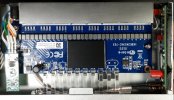radix
Major Contributor
- Joined
- Aug 1, 2021
- Messages
- 1,409
- Likes
- 1,349
hi sq225917,
well...
please have a try : change a clock (or quartz) and then you'll talk about.
no test... well... I'd be like you : WTF changing a clock on a switch ? Theoricaly : useless (of course vs tcp/ip protocol)
but streaming is is not based on tcp/ip, it's real-time stuff !
thus... open a switch / take off the basic quartz / stick a brand new tcxo or oxco : and then => give your conclusions !
no brainer guys, I know that I know nothing
@Jinjuku also addressed this, but I'll add my 2 cents.
Digital audio -- that is AES/spdif/toslink (they are basically the same protocols) -- are real time. They transfer digital audio sound samples in time slots. Here clock accuracy is important, up to some degree. There's other threads about digital audio clocks.
Streaming protocols are most definitely not real time. Digital audio uses the time slot of a sample to determine when to play it. Streaming protocols put a timestamp in the packet to say when to play the clock sample in the packet. This allows the player to buffer the samples from the packets and even reorganize them in time (e.g. packet 2 arrived before packet 1 and they get reordered so they play correctly). Depending on your network, there may be significant buffering to mask out delay and jitter variations.
A lot of streaming protocols use TCP, which means "packet" is not really that important as it's transferred as a byte stream and TCP will take care of re-ordering packets and re-transmit dropped or delayed packets. TCP is most definitely not real-time.
Marc

